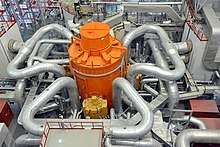BN-800 reactor
The BN-800 reactor is a sodium-cooled fast breeder reactor, built at the Beloyarsk Nuclear Power Station, in Zarechny, Sverdlovsk Oblast, Russia. The reactor is designed to generate 880 MW of electrical power. The plant was considered part of the weapons-grade Plutonium Management and Disposition Agreement signed between the United States and Russia, with the reactor being part of the final step for a plutonium-burner core. (a core designed to burn and, in the process, destroy, and recover energy from, plutonium) [1] The plant reached its full power production in August, 2016.[2] According to Russian business journal Kommersant, the BN-800 project cost 140.6 billion rubles (roughly 2.17 billion dollars).[3]
| BN-800 | |
|---|---|
 | |
| Generation | Generation IV |
| Reactor concept | Fast breeder reactor |
| Status | Operational |
| Location | Zarechny, Sverdlovsk Oblast, Russia |
| Main parameters of the reactor core | |
| Fuel (fissile material) | U+Pu nitride, MOX, or metal |
| Fuel state | Solid |
| Neutron energy spectrum | Fast |
| Primary coolant | Liquid sodium |
| Reactor usage | |
| Power (thermal) | 2100 MWth |
| Power (electric) | 789 MWe net 885 MWe gross |
Design
The plant is a pool-type reactor, in which the reactor, coolant pumps, intermediate heat exchangers and associated piping are all located in a common liquid sodium pool. The design of this plant was started in 1983 and was completely revised in 1987 after the Chernobyl Disaster and to a somewhat lesser degree in 1993, according to the new safety guidelines. After the second revision, the electric output power was increased by 10% to 880 MW due to the increased efficiency of the planned power generator steam turbines.
The reactor core is, in size and mechanical properties, very similar to the BN-600 reactor core, but the fuel composition is very different. While BN-600 uses medium-enriched uranium dioxide, this plant burns mixed uranium-plutonium fuel,[4] helping to reduce the weapon-grade plutonium stockpile and provide information about the functioning of the closed uranium-plutonium fuel cycle. It was highlighted that the closed cycle will not require plutonium separation or other chemical processing.
The unit employs a three-circuit coolant arrangement; sodium coolant circulates in both the primary and secondary circuits. Water and steam flow in the third circuit. This heat is transferred from the reactor core via several independent circulation loops. Each comprises a primary sodium pump, two intermediate heat exchangers, a secondary sodium pump with an expansion tank located upstream, and an emergency pressure discharge tank. These feed a steam generator, which in turn supplies a condensing turbine that turns the generator.[5]
Many infrastructure facilities were designed to accommodate both the BN-800 and a proposed follow on BN-1200 reactor.[6]
History
The construction of BN-800 started in 1983 as Unit 4 at the Beloyarsk nuclear power plant but was put on hold after the 1986 Chernobyl accident. It resumed in 2006 and BN-800 achieved minimum controlled power in 2014, but issues led to further fuel development work. On 31 July 2015, the unit achieved minimum controlled power again, at 0.13% of rated power. Commercial operations was expected to start before the end of 2016, with a power rating of 789 MWe.[6] The reactor was connected to the electricity grid in February 2016[7] and achieved full power for the first time in August 2016.[2] Commercial power production started on November 1, 2016.[8]
With both the United States and Russia reaching an agreement in 2001 to render a joint 34 tons of weapons grade plutonium, into reactor grade plutonium alongside reaching the spent fuel standard, that is mixed with the other more highly radioactive products within spent fuel.[9]
US president Barack Obama canceled construction of the agreement-supporting US MOX fuel fabrication facility in 2016, citing cost overruns and for financial reasons proposing instead that for the US share of plutonium, it be diluted with non-radioactive material and disposed in the underground WIPP facility.[9][10] However, the dilution could be reversed, and the material reconverted into weapons-grade plutonium.[9]
On October 3, 2016, Russian president Vladimir Putin ordered the agreement to be suspended because the US did not meet their obligations.[11]
In January 2020 the reactor started commercial operation with the first batch of MOX reprocessed uranium-plutonium fuel.[12]
References
- http://scienceandglobalsecurity.org/archive/sgs22kutt.pdf
- "Russian fast reactor reaches full power". www.world-nuclear-news.org. Retrieved 21 April 2018.
- "Rosatom postpones fast reactor project, report says". www.world-nuclear-news.org. Retrieved 13 August 2019.
- "Mox fuel for Russia's BN 800 - Nuclear Engineering International". www.neimagazine.com. Retrieved 16 October 2017.
- "Фотографии со строительства блока с реактором БН-800 на Белоярской АЭС". atominfo.ru. Retrieved 21 April 2018.
- "Fast reactor progress at Beloyarsk". Nuclear Engineering International. 14 January 2016. Retrieved 19 January 2016.
- "Russian Fast Reactor Connected to the Grid". powermag.com. 1 February 2016. Retrieved 21 April 2018.
- "Russia's BN-800 unit enters commercial operation". www.world-nuclear-news.org. Retrieved 21 April 2018.
- Pavel Podvig: Can the US-Russia plutonium disposition agreement be saved? Bulletin of the Atomic Scientists, 28. April 2016.
- "Obama seeks to terminate MOX project at Savannah River". World Nuclear News. 10 February 2016. Retrieved 6 July 2017.
- Указ Президента Российской Федерации от 03.10.2016 № 511 (in Russian).
- Larson, Aaron (2020-01-28). "MOX Nuclear Fuel Loaded in Russian Reactor, More to Come". POWER Magazine. Retrieved 2020-03-05.
External links
- Official website

- "BN-800 Fast Neutron Reactor" (PDF). - on OKBM Afrikantov official pdf(in English)
- B.A. Vasilyev; S.F. Shepelev; M.R. Ashirmetov; V.M. Poplavsky (4 March 2013). "BN-1200 Reactor Power Unit Design Development" (PDF). International Conference on Fast Reactors and Related Fuel Cycles: Safe Technologies and Sustainable Scenarios (FR13) Presentations, (p. v). International Atomic Energy Agency (IAEA): IAEA. IAEA. Retrieved 14 March 2019.
- The BN-800 Fast Reactor – a Milestone on a Long Road